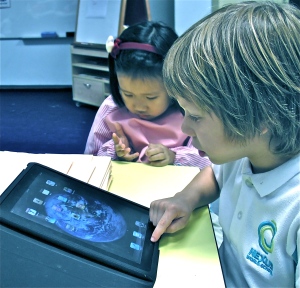Original blog post here
Why use iPads in K12 Education?
To be successful when using technology in education one should focus on learning, engagement, creativity, inquiry-based learning, and differentiated instruction over the technology tools used to amplify learning. I believe that IPad’s and other digital learning devices are a critical part of the learning process. The point of using an iPad in the classroom shouldn’t be simply to use the digital device, but to provide a tool to aid learning this will empower learner’s to engage in the transformation of learning experiences, which would not be possible without the aforementioned technology. What I believe we do want to do as educators, is to teach our children to be creative problem solvers, we want them to be leaders who can analyze a variety of sources for bias while synthesizing information to create a thorough understanding of a problem so that they can engage in dialogues to affect solutions. To do this we need to educate them and provide them with the right technology to achieve these outcomes. This is why I believe that the iPad is the right tool, in addition to other mobile devices and Apple learning platforms.
7 Key Reasons for using the iPad in Education:
Learning Styles:
The iPad is a streamlined, visually attractive tablet that is used primarily as a platform for audio-visual media including books, periodicals, movies, music, games, and web content. The auditory, kinesthetic and visual aspects of the tablet appeal to a variety of different learners and learning styles. The iPad enables personalized learning by giving learners the responsibility and ownership to choose how they learn, when they learn and where they learn; as well as developing their organizational skills.
Creativity:
The vast numbers of Apps allow all types of learners from different age groups to be creative by expanding the learning experience both inside and outside the classroom, from interactive lessons to study aids to productivity tools. The use of iMovie and GarageBand provide opportunities for all learners to show their creative nature and skills.
Technical:
The iPad requires minimal maintenance (as with most Apple products) and installation of software. The iPad boots up much faster than other mobile devices, since it has a solid-state hard drive, there is minimal waste of time in connecting to the network and logging in. The iPad has its own operating system and software, which is optimized to ensure the ease of use and fast access to its software and Apps.
Accessibility:
Learners have accessibility to the world 24/7 (subject to internet access). Students don’t need to carry a huge amount of textbooks, dictionaries, thesaurus, atlas etc. The iPad has accessibility built in, it comes with a screen reader, support for playback of closed-captioned content, and universal zoom feature which provides magnification of the entire screen of any application. It also supports a wireless Braille display and international Braille tables.
Battery Life:
The battery life is relatively long; the iPad 2 can stay charged for the entire school day, although learners need to take responsibility for charging the device. On average I would say at least 7 hours.
Any Age and Anyone:
The iPad can be used by anyone, at any age from pre-school through to adult life. I have found it especially useful for learners who have learning difficulties, the ability to create something which is easy to use and can improve the progress of learning of everyone, regardless of ability, is a powerful tool.
Motivation:
I have seen many talk about the Hawthorne effect with the iPad, being a new technological tool for learning in the classroom, this maybe true. However, anyone who has been in a class of K12 learners who are all using an iPad will see the response from the learners is one of engagement, wonderment, learning and of progress. It is fair to say this may be short lived, although I believe it will be prolonged and of course Apple will bring another adapted tablet or a new product in a year or two which again revolutionizes mobile technology as a tool to aid learning in the classroom and beyond.
There are many other factors to consider, which are not mentioned here, the one of cost and budgetary requirements comes to mind. Also as previously stated, the adoption of technology will only be successful if the associated pedagogy relates to the correct use of mobile devices in the classroom and associate learning philosophy. As my school is a 1:1 Apple school it makes sense for us to continue to adopt Apple technology. I am sure there are other android based tablets that will also aid learning in education.
By Steven David Pearce 26th May 2011
Comment
© 2025 Created by Steve Hargadon.
Powered by
![]()


You need to be a member of Classroom 2.0 to add comments!
Join Classroom 2.0